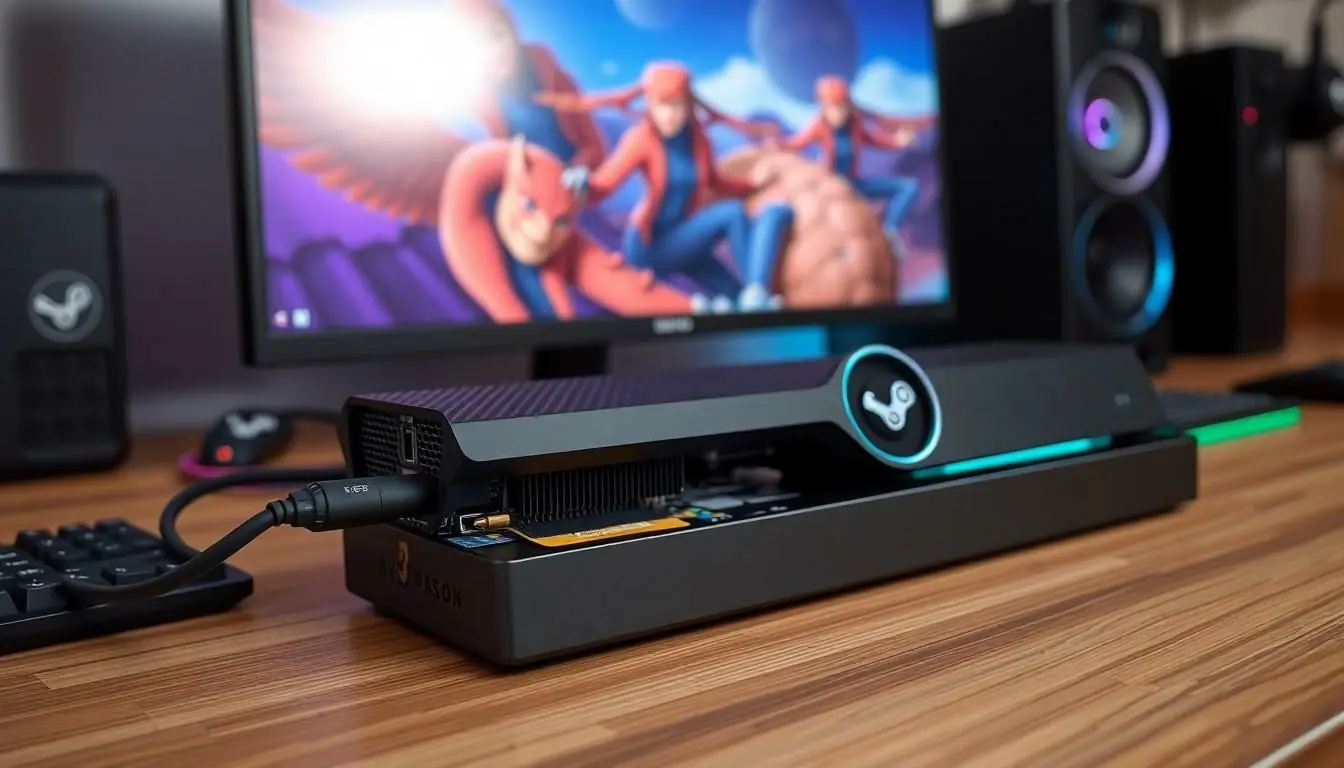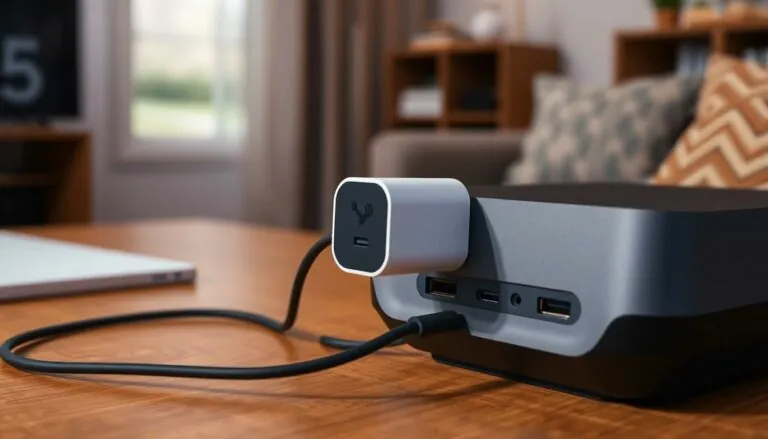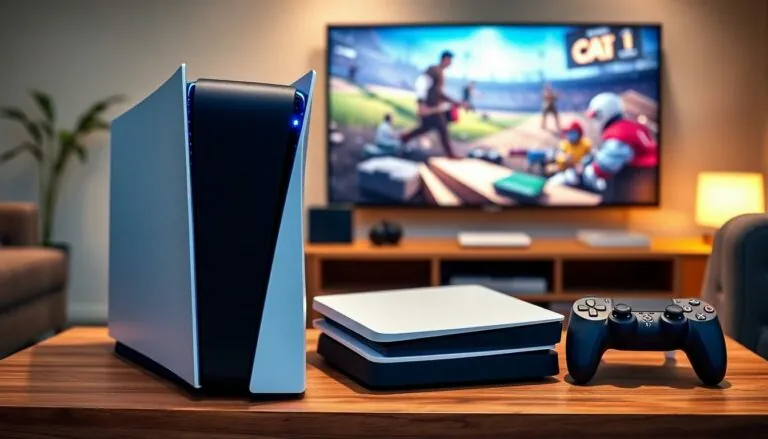Table of Contents
ToggleThe Steam Deck has taken the gaming world by storm, but what if it could be even more powerful? Enter the eGPU, the secret weapon that can transform this handheld console into a gaming powerhouse. Imagine playing your favorite titles with stunning graphics and blazing speeds, all while lounging on your couch or pretending to work at a coffee shop.
With the right eGPU, gamers can unlock a treasure trove of performance, making those pixelated dreams a reality. It’s like giving your Steam Deck a turbocharger—suddenly, it’s not just a handheld device; it’s a portable gaming rig that can rival some of the best desktop setups. So grab your favorite snack, sit back, and let’s explore how an eGPU can elevate your Steam Deck experience to epic levels.
Overview of Steam Deck eGPU
Steam Deck’s eGPU capability allows users to unlock enhanced graphics performance, transforming the gaming experience. An external graphics processing unit can provide significant improvements in frame rates and visuals. Gamers using an eGPU can access higher resolutions and detailed graphics that handheld consoles typically struggle to deliver.
Compatibility with various eGPUs exists, giving users multiple options based on budget and gaming needs. A variety of brands, including Razer and Akitio, produce eGPUs that work with the Steam Deck. Installation typically involves connecting the eGPU via the USB-C or Thunderbolt port, simplifying the setup process.
Using an eGPU offers notable advantages for gamers who prioritize performance. They can enjoy demanding titles such as “Cyberpunk 2077” and “Red Dead Redemption 2” at higher settings seamlessly. Moreover, reducing load times with improved processing speeds enhances overall user satisfaction.
Additionally, eGPUs provide the flexibility to expand gaming options beyond the Steam Deck. Users can connect to larger monitors or projectors, facilitating communal gaming experiences or competitive setups. This versatility ensures the device remains relevant as gaming technology evolves.
Investing in an eGPU is a strategic choice for maximizing the Steam Deck’s potential. Gamers can experience a desktop-level performance in a portable format, bridging the gap between handheld and traditional gaming devices. Exploring this enhancement can lead to significantly more enjoyable and engaging gameplay.
Compatibility

Compatibility plays a crucial role in enhancing the Steam Deck’s gaming experience with an eGPU. Gamers must consider supported graphics cards and connection methods when selecting an external GPU.
Supported GPUs
Many graphics cards from reputable brands are compatible with the Steam Deck. Popular options include NVIDIA’s RTX 30 series, such as the RTX 3060 and RTX 3080, and AMD’s Radeon RX 6000 series. Users benefit from higher frame rates and improved visuals when using these GPUs. Ensure the selected graphics card meets performance expectations and fits within personal budget constraints.
Connection Methods
Streamlined connection methods simplify eGPU integration. The Steam Deck features a USB-C port that supports Thunderbolt 3, making it easy to connect an eGPU. Various adapters and docks are available to facilitate this connection. Plug-and-play functionality allows users to quickly set up and start gaming. Proper configuration is essential for optimal performance, so follow the manufacturer’s guidelines for installation.
Performance Analysis
Integrating an eGPU with the Steam Deck greatly enhances overall performance, especially in gaming and productivity applications.
Gaming Performance
Gamers experience significant improvements in frame rates and graphic fidelity with an eGPU. High-demand titles, such as “Cyberpunk 2077” and “Red Dead Redemption 2,” run smoothly, often at ultra settings. The combination of an eGPU and the Steam Deck allows for graphically intensive games to render at higher resolutions. Many users report reductions in load times, further enhancing gameplay. Support for NVIDIA’s RTX 30 series and AMD’s Radeon RX 6000 series boosts performance, leading to a more immersive gaming experience. The setup becomes even more appealing when considering the ability to play on larger displays, enhancing group gaming sessions.
Productivity Applications
Using an eGPU transforms the Steam Deck into a capable workstation for productivity applications. Users handle demanding tasks, such as video editing and 3D rendering, with increased efficiency. The addition of a powerful graphics card supports software that requires substantial graphical power. Many professionals find the enhanced processing capabilities beneficial for running multiple applications simultaneously. Faster rendering times improve workflow, while high-quality visuals elevate presentations and creative projects. With compact hardware available, users enjoy the flexibility of a portable setup with desktop-level productivity.
Setup Process
Setting up an eGPU with the Steam Deck enhances gaming experiences significantly. This setup process involves essential tools and a straightforward guide.
Required Tools
Gamers require several tools for the setup. An eGPU compatible with the Steam Deck is essential. A USB-C cable or Thunderbolt 3 cable facilitates the connection. Depending on the chosen eGPU, a power supply ensures adequate energy. Adapters may be necessary for specific setups, while a monitor enhances the visual experience.
Step-by-Step Guide
Start by connecting the eGPU to the Steam Deck using the USB-C or Thunderbolt 3 cable. Power the eGPU on to trigger its detection. Next, ensure that the Steam Deck recognizes the eGPU. Access the settings to adjust graphics options according to preferences. Finally, launch a game to test performance, confirming that enhanced graphics and speed are achieved. Following these steps guarantees an efficient eGPU integration, maximizing the Steam Deck’s gaming potential.
Limitations and Drawbacks
Using an eGPU with the Steam Deck comes with various limitations and drawbacks. Performance gains can vary based on the eGPU model and the specific game being played. Many users experience a bottleneck with the Steam Deck’s hardware, which might not fully leverage the eGPU’s capabilities in certain scenarios.
Compatibility issues may arise with some eGPUs, even if most modern units support the Steam Deck. Installation poses challenges since meticulous configuration ensures optimal performance, requiring users to follow detailed guidelines. Latency can be a concern, particularly with demanding games, leading to reduced responsiveness during gameplay.
Cost represents another significant factor when considering an eGPU. Users might find investing in both the eGPU and the appropriate graphics card adds up, potentially exceeding the price of a traditional desktop setup. Space limitations also enter the discussion, as eGPUs and their associated hardware require additional room, which can be problematic for users with limited workspace.
Reliability of performance creates another hurdle. Inconsistent performance may lead to a frustrating gaming experience, especially when high graphics settings result in unexpected frame drops. Troubleshooting setups can consume valuable time, demanding users’ patience and technical knowledge.
Additionally, the eGPU setup can hinder the portability that the Steam Deck offers as a handheld console, contradicting its primary appeal. Frequent disconnections or hardware errors can detract from convenience, ultimately leading users to reassess whether the eGPU investment is worth the effort. Performance degradation during intense gaming sessions may deter some users from fully utilizing their eGPU’s capabilities.
Conclusion
The integration of an eGPU with the Steam Deck presents an exciting opportunity for gamers seeking enhanced performance and visual fidelity. While it transforms the handheld console into a formidable gaming machine, users should weigh the benefits against potential drawbacks.
Understanding compatibility and configuration is crucial for maximizing the experience. The ability to access high-demand titles and enjoy productivity tasks adds versatility to the Steam Deck. However, considerations like cost and performance variability must not be overlooked.
Ultimately, for those ready to invest in an eGPU, the payoff can be a captivating gaming experience that rivals traditional setups, making it a worthwhile exploration for dedicated gamers.







